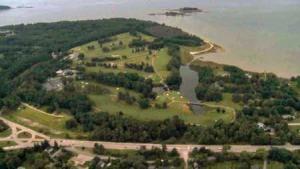Falmouth Facts & Figures

What can you tell me about Falmouth and the Portland area?
Falmouth, located on scenic Casco Bay, was incorporated in 1718 and, at that time, encompassed Portland and other neighboring communities. Its current 30-square mile land area was finalized in 1871. Throughout the 1800s the Town had many mills and several shipyards, primarily along the Presumpscot River. By 1900, Falmouth began to take shape as a suburban community with conversion of summer homes into year-round residences, trolley service from Portland, and later automobile traffic.
In the past 50 years, Falmouth has grown from a quiet, small town of just over 4000 people to a bustling suburb of over 10,000. It is part of the Greater Portland area, which has some 350,000 inhabitants. Portland is the finance, commerce and cultural capital of northern New England as well as Maine’s largest city.
In the mid-1950s, the primary land use in Falmouth was agriculture, with the vast majority of the town’s populace living in the eastern portion of the community. The transformation of Falmouth started with the construction of the interstate system (I-295 and the Maine Turnpike), which divided the community with major physical barriers and provided ready access for future commuters to the Portland job market.
The highways and a new sewer treatment plant stimulated commercial development on Routes 1 and 100, with more than a million square feet of non-residential space. The availability of sewer collection and treatment also made it possible for a 1970s boom in multi-family housing on the eastern part of town, including several large condominium projects. In recent decades, single-family homes have spread in the western sections of town.

Today, Falmouth boasts three private golf courses, the Portland Yacht Club, the largest anchorage in Maine (with over 1200 moorings), and many preserved open spaces and recreation areas located throughout the community, including:
- Mackworth Island, a State-reserved land of about 100 acres, which was donated by Governor Baxter and affords views of Casco Bay and Portland, and
- Gilsland Farm, headquarters of the Maine Audubon Society, which includes 2-1/2 miles of trails through a 60-acre sanctuary of fields, woods, and marsh bordering the Presumpscot River.
Falmouth’s single largest taxpayer in the community is OceanView at Falmouth, a retirement complex. Falmouth’s proximity to Portland allows its residents to take benefit of the urban amenities which that city offers.
Falmouth boasts high educational quality for its students. In April 2011 it was named “Top City to Live and Learn” by Forbes Magazine and GreatSchools in their second annual national study ranking cities across the United States. Falmouth schools earned an education quality score of 100.00.

Rendering of elementary school in Falmouth
Click here for additional links and resources

